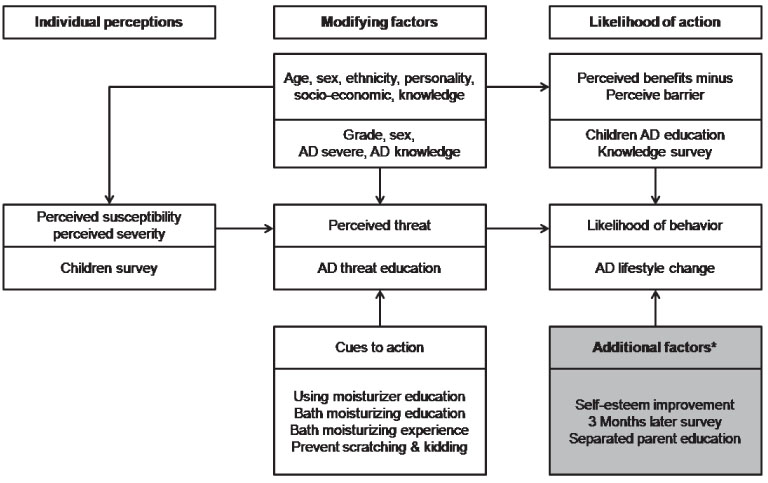Pediatr Allergy Respir Dis.
2012 Jun;22(2):154-162.
Effectiveness of the Atopy Camp for Primary School Students in Seoul
- Affiliations
-
- 1Atopy Research Institute, Seoul Medical Center, Seoul, Korea. hojang@dankook.ac.kr
- 2Atopy Asthma Center, Seoul Medical Center, Seoul, Korea.
- 3Department of Preventive Medicine, Dankook University College of Medicine, Cheonan, Korea.
Abstract
- PURPOSE
In this study, we attempted to analyze the effectiveness of the atopic dermatitis camp for primary school students in the Seoul area.
METHODS
Seoul city's atopy camp 2010 was conducted 10 times from May 22nd to October 24th for primary school students at an atopy friendly school and their parents. A total of 374 atopic dermatitis patients participated in the camp and questionnaires for 363 were analyzed, except 11 participants who had left several questions unanswered. In a 3-month follow-up survey, 167 participants out of 374 responded to the mailing questionnaire to evaluate the efficiency of the camp. The response rate was 44.7%.
RESULTS
Satisfaction with the educational program of the camp was higher for lower grade students than for higher grade students.(P<0.001) Before camp, higher grade students (P<0.001) or students with severe symptoms were more knowledgeable of atopic dermatitis.(P<0.01) After the camp, the higher the grade, the more the knowledge the student had about atopic dermatitis.(P<0.001) Three months after the camp, there was positive change in the lifestyle of atopic dermatitis patients.(P<0.001)
CONCLUSION
Knowledge on atopic dermatitis increased and the lifestyle of atopic dermatitis patients was improved due to the camp. Consequently, Seoul city's atopy camp can be utilized as a method to improve the quality of life of atopic dermatitis patients and their family. And Seoul city's atopy camp is expected to be a model for atopy camps in other local communities.
MeSH Terms
Figure
Reference
-
1. Pyun BY. Risk factors of atopic dermatitis in young children. Pediatr Allergy Respir Dis. 2005. 15:235–237.2. Lee S, Han K, Lee K, Kwon H, Cho H, Kim J. The influence of national park healing camp on patients with atopic dermatitis. J Korean Ins For Recreation. 2010. 14:45–50.
Article3. Hong SJ. Epidemiology of childhood asthma and allergic diseases. Pediatr Allergy Respir Dis. 2007. 17:S55–S66.4. Kwon HJ, Hong SY, Son DK. Atopic disease prevalence and epidemiology study 2008. 2008. Seoul: Atopy Research Institute.5. Kim DH, Kang KH, Kim KW, Yoo IY. Management of children with atopic dermatitis. Pediatr Allergy Respir Dis. 2008. 18:148–157.6. Cho MR, Hong SY, Kwon HJ, Yum HY, Kim HJ, Lee SH, et al. Effectiveness of the educational program in atopy camp. J Skin Barrier Res. 2010. 12:87–98.7. Nicol NH, Ersser SJ. The role of the nurse educator in managing atopic dermatitis. Immunol Allergy Clin North Am. 2010. 30:369–383.
Article8. Park YJ, Han KS. The trends of nursing research on management of the patients with chronic illness. Korean J Nurs Query. 2002. 11:32–48.9. Choi YH. Effects of camping programs on self-efficacy and sick-role behavioral compliance in juvenile diabetes mellitus patient. J Korean Soc Health Educ. 1997. 14:59–68.10. Lim J, Choung JT. A model of camp program for childhood asthma. Pediatr Allergy Respir Dis. 1998. 8:155–166.11. Yoon IK, Jnag MH, Kim GT, Park DH, Seo JY, Park SY, et al. Development and application of health belief model based milk education program for primary, middle, and high school students. J Korean Home Econ Educ Assoc. 2007. 19:17–36.12. Hanson JA, Benedict JA. Use of the health belief model to examine older adults' food-handling behaviors. J Nutr Educ Behav. 2002. 34:Suppl 1. S25–S30.
Article13. Kwon KW, Kam S, Park KS. Factors affecting health practice of primary school students: based on health promotion model. Korean J Prev Med. 2000. 33:137–149.14. Im MY, Youn YM. Effects of a smoking prevention education on elementary school students. J Korean Soc Health Educ Promot. 2009. 26:39–50.15. Akdis CA, Akdis M, Bieber T, Bindslev-Jensen C, Boguniewicz M, Eigenmann P, et al. Diagnosis and treatment of atopic dermatitis in children and adults: European Academy of Allergology and Clinical Immunology/American Academy of Allergy, Asthma and Immunology/PRACTALL Consensus Report. J Allergy Clin Immunol. 2006. 118:152–169.
Article16. Cho SE, Jeon JE, Cho H, Son DK, Kim HO, Lee SH, et al. Psychological intervention in an integrated health care service for children with atopic dermatitis. Korean J Asthma Allergy Clin Immunol. 2010. 30:100–109.17. Lim YJ. Children and parents' satisfaction and educational effect variation of summer family camp in Korea national arboretum. J Korean Ins For Recreat. 2008. 12:45–56.18. Kang DH, Ahn YO. A response pattern of mailing questionnaires. Korean J Prev Med. 1988. 21:451–453.19. Shin EK, Lee JH, Lee YK, Lee HS. Effect of short-term nutrition education camp on food and nutrient intakes of obese children. J Korean Soc Food Sci Nutr. 2005. 34:987–999.
Article20. Sung MK, Sung JJ, Yoo WC, Park JN, Park DY, Choi MK, et al. The evaluation of a nutrition education camp program for overweight and underweight adolescents. Korean J Community Nutr. 2003. 8:504–511.
- Full Text Links
- Actions
-
Cited
- CITED
-
- Close
- Share
- Similar articles
-
- Effect of Diabetic Camp Program on the Depression, Self-Efficacy and Self-Esteem in Diabetic Children and Adolescent
- Evaluation of Spot CAMP Test for Rapid Identification of Group B Streptococci
- Comparative Study of Nursing Students Consciousness of Biomedical Ethics and Attitudes toward Human Tissue Donation and Transplantation According to Participation in Anatomy Camp Program
- Developing and Evaluating a Camp-style Leadership Enhancement Program for Nursing Students
- Effects of Diabetic Camp in Type 2 Diabetic Patients


